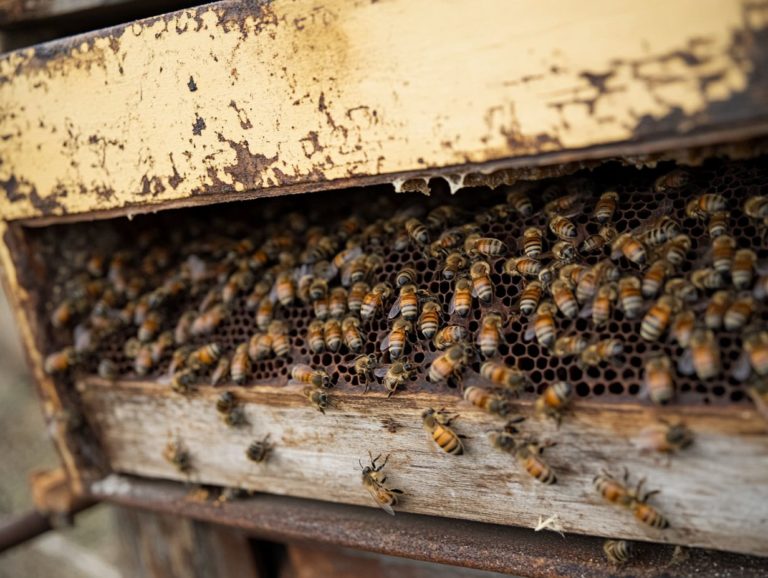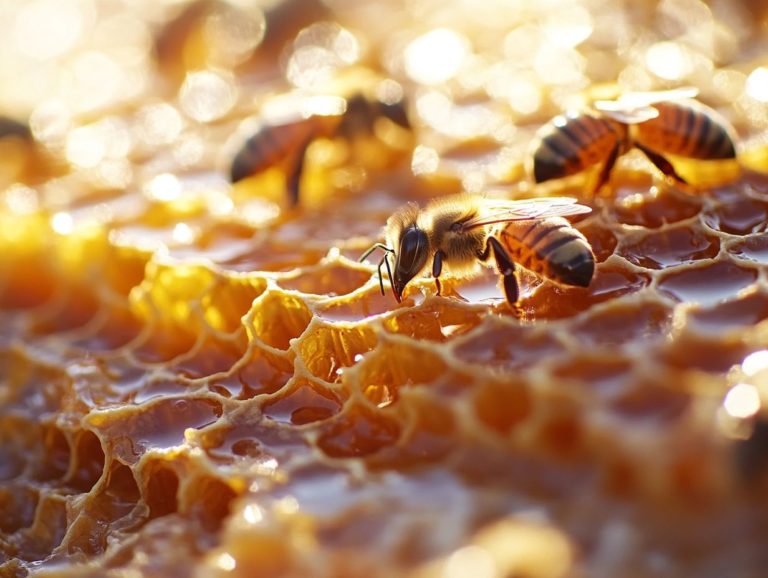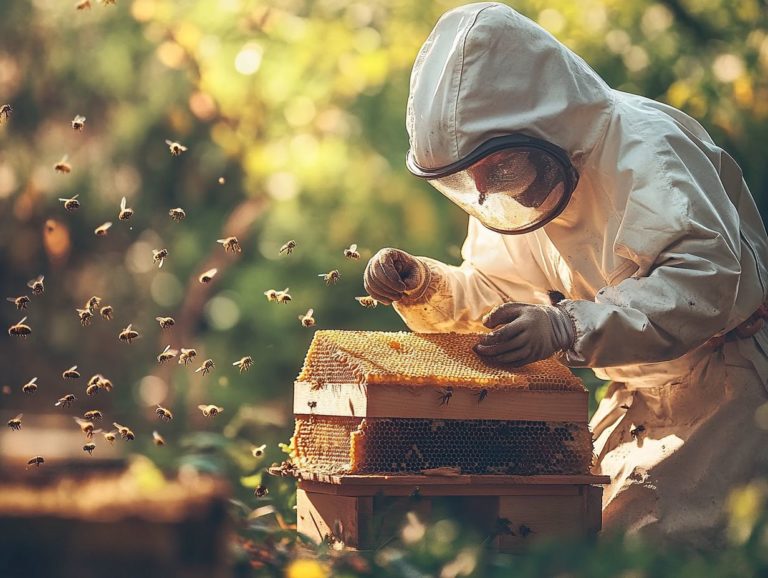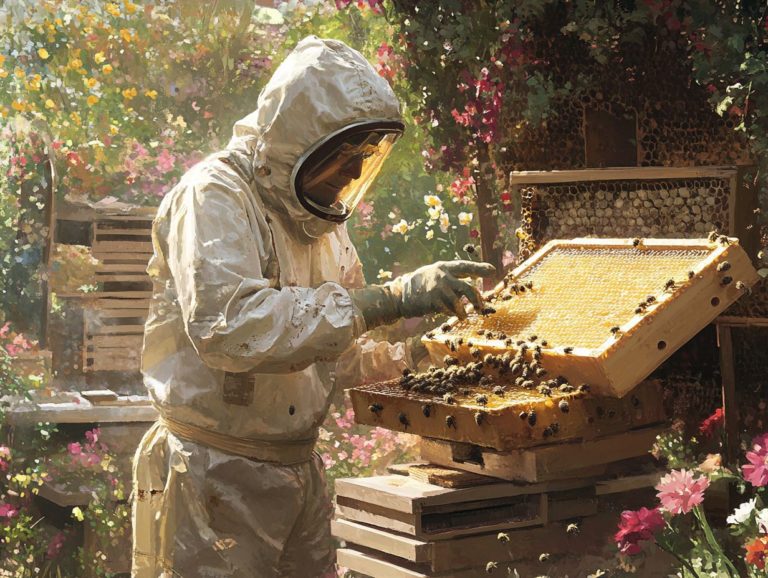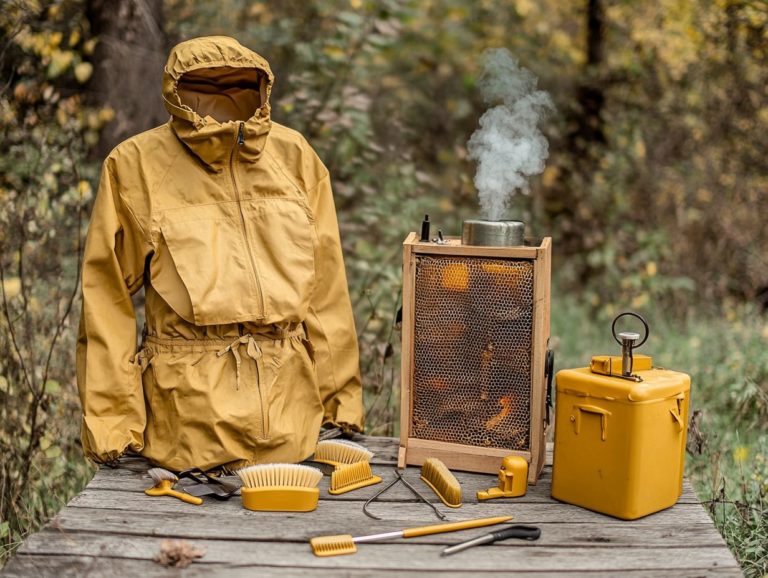Essential Tools for Hive Management
Effective hive management is essential for the health of bee colonies and the success of your beekeeping endeavors. Utilizing proper beekeeping equipment ensures that tasks like inspecting hive conditions and maintaining cleanliness are efficiently performed.
Equipped with the right tools, such as a hive tool and protective gear, you can monitor, maintain, and nurture your hives. This creates a thriving environment for these indispensable pollinators.
Discover ten must-have tools that will elevate your beekeeping game! This article delves into how these tools facilitate hive management, address common challenges such as small hive beetles, and illustrates how proper management benefits both the bees and their keepers.
Whether you’re a seasoned apiarist or just beginning your journey, mastering these tools will instantly transform your beekeeping journey! Reading beekeeping books by experts like Richard E. Bonney or publications from Storey Publishing can also provide valuable insights.
Contents
- Key Takeaways:
- 1. Hive Tool
- 2. Smoker
- 3. Bee Brush
- 4. Queen Catcher
- 5. Frame Grips
- 6. Uncapping Knife
- 7. Honey Extractor
- 8. Protective Gear
- 9. Feeder
- 10. Swarm Catcher
- What Is Hive Management and Why Is It Important?
- Common Questions About Hive Management
- What are the essential tools for hive management?
- Why is a hive tool important for hive management and beekeeping?
- What is the purpose of a smoker in hive management and beekeeping?
- How does a bee brush aid in hive management and beekeeping?
- What is the function of a hive beetle trap in hive management and beekeeping?
- Why is a queen excluder important for hive management and beekeeping?
Key Takeaways:
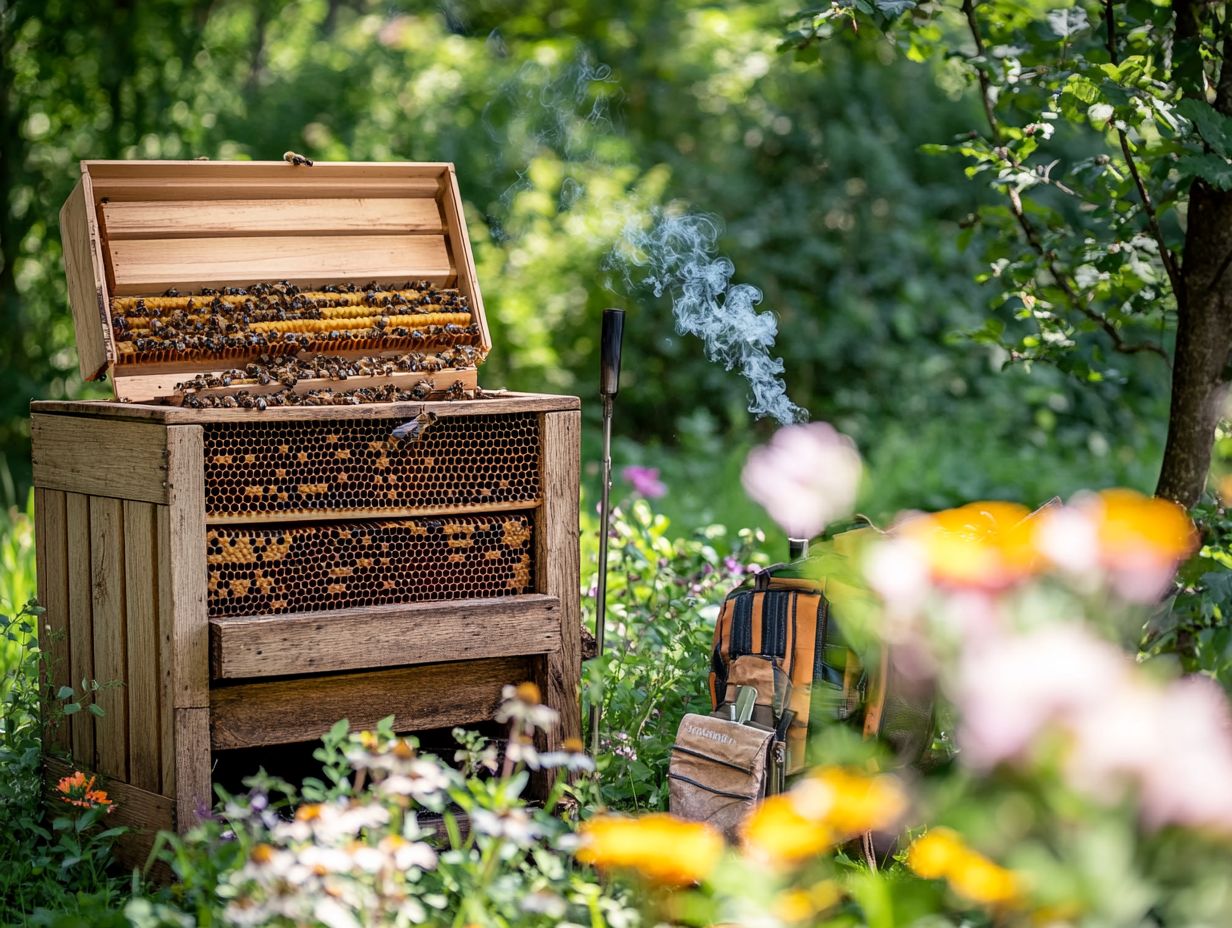
- Proper hive management is essential for the health and productivity of bee colonies.
- Essential tools like the hive tool, smoker, and bee brush aid in tasks such as hive inspection and honey extraction.
- Choosing the right tools and using them correctly can help prevent common challenges like disease and swarming, benefiting both bees and beekeepers.
1. Hive Tool
A hive tool is an essential asset in your beekeeping toolkit, designed to help you with various tasks such as inspecting the hive, managing frames, and maintaining cleanliness by scraping off bee propolis.
This multifunctional instrument not only helps you access the hive but also enables you to handle both the bees and their environment with care. This makes it essential for your success as a beekeeper.
Familiarizing yourself with the different types of hive tools such as the standard hive tool, the J hook, and the multifunction scraper is crucial for optimizing your hive maintenance and managing your colonies effectively.
These tools are fundamental in the field of beekeeping, facilitating tasks from cleaning hive areas to making adjustments to hive feeders. By utilizing these specialized tools, you can enhance your efficiency and ensure the well-being of your bees, ultimately leading to better honey production.
For example, the standard hive tool, featuring a flat edge and a hook, is invaluable for prying apart frames that may have become stuck together by propolis. This allows you to conduct thorough inspections without causing harm to your bees.
Similarly, the J hook tool helps you handle frames gently, reducing stress on the bees and minimizing disruption within the hive. Maintaining a clean hive is vital for preventing diseases and pests like small hive beetles, and these tools play a key role in scraping off debris and wax buildup.
Regularly employing hive tools not only promotes cleanliness within your hive but also supports effective colony management, ensuring that your bees thrive and flourish.
2. Smoker
A smoker is an essential tool in your beekeeping arsenal, invaluable for calming bees during hive inspections and maintenance. It ensures both your safety and the well-being of the bees. Smokers have been effectively used in beekeeping practices at institutions like Buckfast Abbey.
This device works by generating cool smoke using various types of fuel, including hardwood, pine needles, or burlap. The smoke masks the alarm pheromones released by the bees, reducing their aggressive tendencies and fostering a calmer environment within the hive.
To use a smoker properly, consider these techniques:
- Ensure you light the fuel adequately to produce a consistent stream of smoke.
- Gently puff the smoke at the entrance and around the frames during your inspections.
This careful application not only keeps the bees subdued but also facilitates a peaceful interaction. This allows you to conduct thorough examinations and necessary hive management without adding undue stress to your colony.
3. Bee Brush
A bee brush is an essential tool in your beekeeping arsenal. It is specifically designed to gently remove bees from frames and other surfaces without causing them harm. This ensures that your hive inspections are smooth and safe.
Typically crafted with soft bristles attached to a sturdy handle, the design of a bee brush is crucial. It provides both comfort to the bees and control for you as the beekeeper. The bee brush helps maintain calmness within the colonies during hive feeder changes. The soft bristles minimize the risk of injury, allowing you to keep the calmness of your colonies during inspections.
By adopting this gentle approach, you significantly reduce stress on the bees, which is vital for their well-being and productivity. Use slow, deliberate strokes to dislodge bees gently. Timing is everything work when the bees are less active, such as early morning or late evening. This strategy respects the bees and streamlines your inspection process, making it more efficient overall.
4. Queen Catcher
A queen catcher is an essential tool for beekeepers. It is expertly crafted to safely capture and isolate the queen bee during hive inspections or management tasks, ensuring her protection at all times.
There are various types of queen catchers available, each designed to meet the unique demands of different hive management scenarios. For example, some are straightforward plastic devices that apply gentle pressure to secure the queen without harming her. Others are more sophisticated, boasting built-in feeding areas or observation windows for your convenience.
You ll find these catchers invaluable during routine inspections. They help prevent accidental injury to the queen, particularly when evaluating hive health or managing colony populations. Safeguarding the queen is crucial for maintaining colony stability, as her well-being directly impacts egg production and the overall vitality of the hive.
A healthy queen is the cornerstone of a strong colony, capable of thriving even in challenging environmental conditions.
5. Frame Grips
Frame grips are essential tools in your beekeeping arsenal. They are designed to help you securely hold and lift frames during hive inspections. This not only simplifies accessing the interior of the hive but also keeps your interactions with the bees as smooth as possible.
You ll find these grips in a variety of styles, from straightforward models perfect for single-handed use to designs that can accommodate multiple frames simultaneously. Typically made from durable materials like stainless steel or high-grade plastic, these tools promise longevity and reliability.
By alleviating unnecessary strain on both yourself and the bees, frame grips enhance your efficiency during inspections. They allow you to assess colony health, honey production, and potential pest issues with ease. However, it’s essential to use these tools correctly; improper handling can lead to bee injuries, disrupt their natural behavior, and ultimately compromise the productivity of your hive.
6. Uncapping Knife
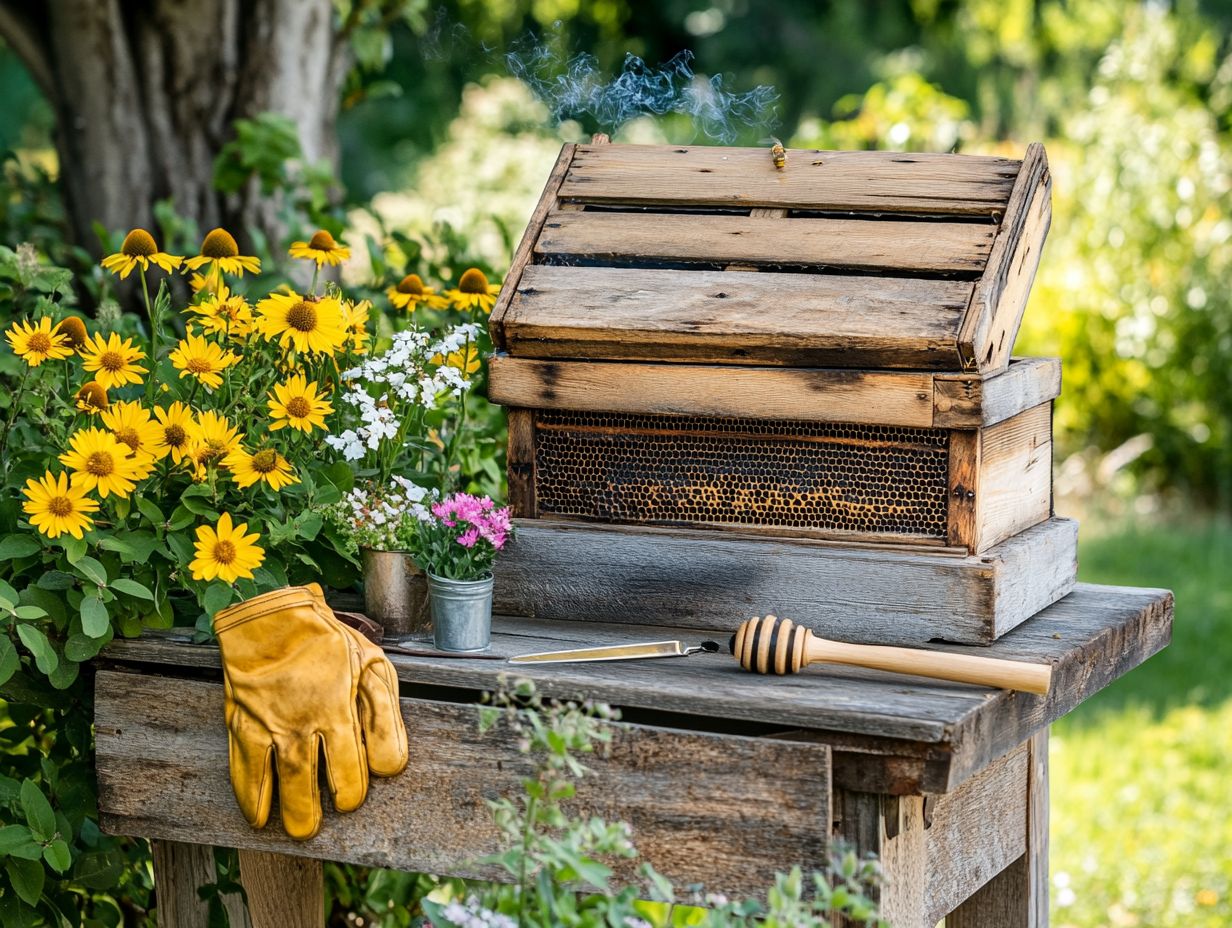
An uncapping knife is an essential tool in your honey extraction toolkit. It removes the wax cappings from honeycomb frames, significantly enhancing your honey extraction process. This technique lets your delicious honey flow effortlessly during extraction.
You ll find these knives in a variety of styles, primarily divided into heated and manual options. Heated uncapping knives utilize electric coils to gently melt the wax, making the entire process quicker and more efficient. Manual knives require a bit more elbow grease, relying on sharp blades to perform the same task.
No matter which type you choose, the uncapping process is pivotal in honey production. It ensures that you can extract the maximum amount of honey from the frames without damaging the comb itself. By mastering this technique, you boost your efficiency and preserve the quality of your final product an absolute must for any beekeeper dedicated to achieving excellence.
Unlock the full potential of your honey production now with a quality uncapping knife!
7. Honey Extractor
A honey extractor is a must-have tool in your beekeeping arsenal. It helps you extract honey from the combs without damaging those precious frames. With this tool, you’ll enjoy more delicious honey than ever!
The device operates on a straightforward yet effective principle: by spinning the frames filled with honey, a force pushes the honey outward into a collection container.
You have two primary options when it comes to honey extractors manual and electric. Manual extractors require a bit of muscle, making them perfect for small-scale operations or hobbyists. On the other hand, electric extractors provide a more efficient solution for larger production, saving you both time and labor.
Whichever type you decide on, these extractors are crucial for maximizing your honey production while keeping the integrity of the hive intact. Effective honey extraction is key to a successful beekeeping operation. Their gentle process helps preserve the beeswax structures, allowing your bees to reuse them in future harvests.
8. Protective Gear
Protective gear is absolutely essential for every beekeeper. It offers crucial safety measures needed to shield you from stings while you manage your bees and conduct hive inspections.
This gear acts as a vital barrier between you and the bees, significantly reducing the risk of those painful stings that could lead to allergic reactions.
Many beekeepers opt for full suits that cover your entire body and include ventilation to keep you cool and comfortable. Gloves, often crafted from leather or synthetic materials, protect your hands from stings while allowing for the dexterity needed to handle frames with ease.
Veils are equally important, ensuring your face and neck are shielded while still providing the visibility required to work effectively with your hives. Wearing gloves and veils is crucial for your safety in beekeeping.
Each piece of gear enhances your overall safety and confidence. This enables you to focus on the important tasks at hand without the distraction or danger of potential stings. Beekeeping equipment such as the queen excluder and frame grippers are also essential in day-to-day hive management.
9. Feeder
A hive feeder is an essential tool for you as a beekeeper. It enables you to provide supplemental food to your bees, especially during times when resources are scarce. This supports the overall health of your hive and boosts productivity.
You ll find various types of hive feeders, including entrance feeders, frame feeders, and top feeders. Each is designed for specific purposes. Entrance feeders, for example, allow your bees to access their food without venturing outside the hive, minimizing disruptions and keeping them focused on their tasks.
The use of a hive feeder is crucial in maintaining optimal nutrition levels in your beekeeping practices. Frame feeders fit snugly within the hive, making it easy for you to monitor consumption while providing a more integrated feeding approach. Meanwhile, top feeders offer ample access, helping to reduce competition among your bees.
By selecting and using these feeder types appropriately, you can ensure your bees receive optimal nutrition. This supports hive maintenance and fosters a resilient population that can thrive even in challenging conditions.
10. Swarm Catcher
A swarm catcher is your essential tool as a beekeeper for capturing swarms of bees that may arise when colonies get overcrowded or when they re seeking a new home. These swarms are a natural occurrence. If managed properly, they present a fantastic opportunity to sustainably increase your hive count.
Familiarize yourself with the different types of swarm catchers available. Some come equipped with mesh nets that make retrieving swarms easy, while others utilize bait traps designed to attract bees with pheromones. To use these tools effectively, consider strategic placement and timing to align with the bees’ natural behaviors.
Mastering swarm management helps you expand your apiary and supports thriving bee populations, ultimately fostering ecological balance. Knowledge from beekeeping books, such as those by Richard E. Bonney published by Storey Publishing, can provide valuable insights into effective swarm management. It s a win-win for you and the environment!
What Is Hive Management and Why Is It Important?
Hive management involves the practices and strategies you employ to keep your bee colonies healthy and productive. This is essential for the long-term success of your beekeeping endeavors. Effective hive management includes regular inspections, monitoring for pests like small hive beetles and Varroa mites, and ensuring the best environment for bees to thrive. Each element significantly influences the health of your bees and your honey production.
Understanding the role of bee propolis, a resinous substance bees produce, can help you maintain hive health. This knowledge allows you to adopt a more sustainable approach to beekeeping.
Routine inspections help you catch early signs of stress or disease. This enables timely interventions that make a difference. Implement effective pest control strategies targeting Varroa mites and small hive beetles to mitigate risks posed by harmful insects while fostering an environment where your bees can thrive and carry out their crucial pollination tasks.
Paying attention to these aspects nurtures a robust colony, leading to increased honey yields. Regular management practices deepen your understanding of bee behavior and colony dynamics, empowering you to make informed decisions that enhance productivity and longevity. Utilize beekeeping equipment like the J hook and multifunction scraper to assist in these efforts.
What Are the Basic Tasks of Hive Management?
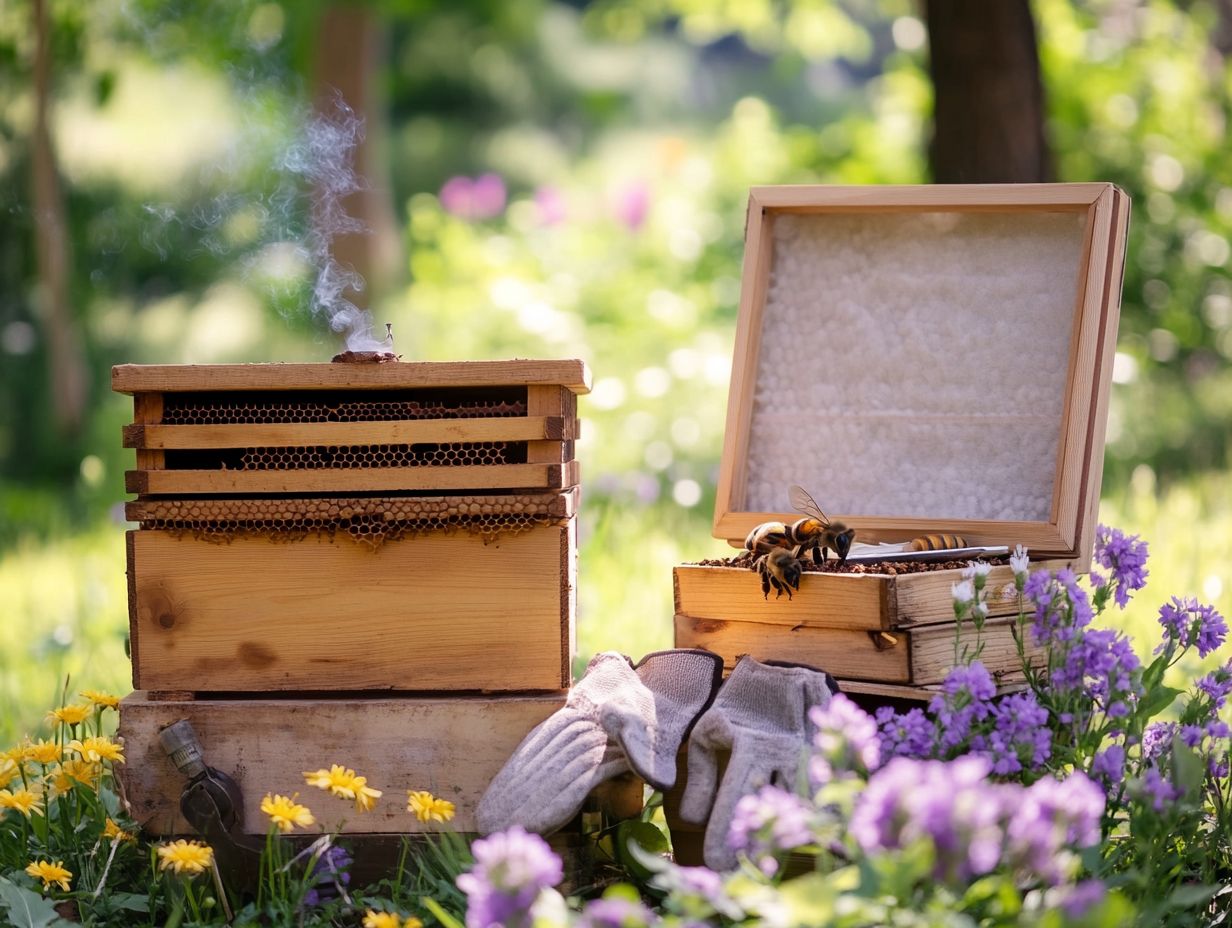
The fundamental tasks of hive management include:
- Inspecting the hive for health and productivity
- Managing pests
- Maintaining optimal conditions for the bees
By regularly checking for bee activity, you gain invaluable insights into the hive’s well-being. This understanding allows you to recognize patterns in foraging and brood development. Inspecting the frames is another essential responsibility. It involves verifying proper honey storage, confirming the queen’s presence, and ensuring there are no signs of disease or pest infestations.
Be vigilant for common issues such as Varroa mites or foulbrood to avert larger problems down the line. Maintaining a clean hive environment is vital, which may involve removing debris and ensuring proper ventilation. Cleaning the hive with specialized tools like the standard hive tool or multifunction scraper is often necessary, and knowing about the 5 tools you need for hive maintenance can be very helpful.
Collectively, these tasks contribute to fostering a thriving bee colony and achieving effective hive management. Ready to improve your beekeeping practices? Dive deeper into these tasks and explore further resources!
What Are Some Common Challenges of Hive Management?
As a beekeeper, you may encounter a range of challenges in hive management. Pests like small hive beetles and varroa mites can significantly affect the health and productivity of your colonies.
Beyond these pests, environmental factors such as fluctuating temperatures, unpredictable weather patterns, and forage availability can complicate your efforts even further. It s essential for you to recognize the signs of stress within your colonies. Don’t wait too long; your bees depend on your quick action to address these issues, as any delay could lead to dire consequences for your bees.
Implementing effective pest management strategies is vital for maintaining strong and thriving hives. This includes regular monitoring and a method that combines different strategies to control pests effectively. By understanding the complex relationship between pests and environmental conditions, you can cultivate more resilient colonies that are better equipped to withstand these common challenges.
How Can These Tools Help with Hive Management?
Utilizing the right hive tools and beekeeping equipment is essential for effective hive management. These tools transform tasks like inspecting the hive, maintaining cleanliness, and managing your bees into a far more efficient experience.
Among the most crucial tools at your disposal are the smoker, hive tool, and uncapping knife. The smoker calms your bees during inspections, allowing you to work without inciting panic within the colony. The hive tool, typically a flat metal implement, is perfect for prying apart frames and scraping away excess propolis, ensuring a healthy environment for your bees. Additionally, using the 5 essential tools for effective hive management can greatly enhance your beekeeping experience.
When it comes time for honey harvesting, the uncapping knife becomes vital, enabling you to remove honey caps with precision. This ensures maximum yield while minimizing any disturbance to the overall health of the hive.
Together, these tools streamline your management tasks and play a significant role in nurturing a productive and thriving beekeeping system.
What Are Some Tips for Choosing the Right Tools for Hive Management?
Choosing the right tools for hive management is vital for beekeepers. The equipment you select can greatly influence the efficiency and safety of your hive maintenance activities.
- Consider your specific needs, including the type of hives you manage be it Langstroth, Top Bar, or Warre.
- If you’re a beginner, focus on essential yet reliable tools like a smoker, hive tool, and bee brush.
- If you’re a seasoned beekeeper, look for specialized equipment designed to enhance productivity or tackle specific challenges within your hives.
- Invest in high-quality protective gear; it shields you from stings and guarantees comfort during lengthy hive inspections.
Ultimately, selecting tools that align with your preferences can transform your beekeeping journey into a successful and enjoyable experience.
How Can Proper Hive Management Benefit the Bees and the Beekeeper?
Proper hive management is a win-win for both you and your bees. It ensures that your colonies flourish, boosting honey production and supporting sustainable beekeeping practices.
By adopting effective hive management techniques, you can closely monitor the health of your colonies, optimize foraging efficiency, and alleviate stress factors that could impact bee populations. This proactive approach boosts your bees vitality and makes beekeeping more rewarding!
Maintaining strong colonies allows you to mitigate risks associated with pests and diseases, creating a safer environment for both your bees and yourself. As you become more skilled at managing your hives, you ll enjoy a more fulfilling beekeeping experience, contributing to the prosperity of your apiary and the vital role bees play in our ecosystem.
The knowledge shared in beekeeping books, like those from Storey Publishing, can provide invaluable insights into sustainable practices.
Common Questions About Hive Management
What are the essential tools for hive management?
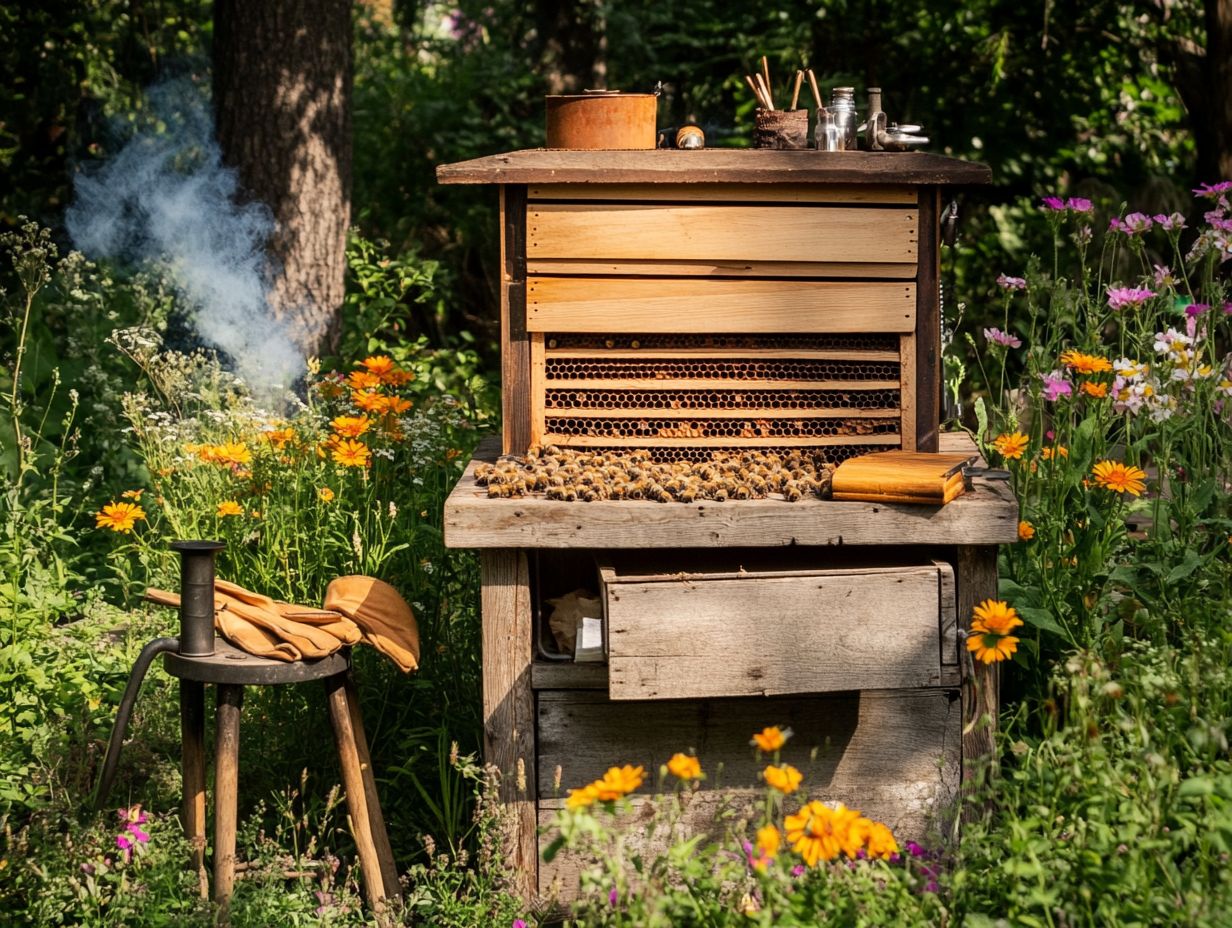
Essential tools for hive management include the smoker, hive tool, uncapping knife, bee brush, hive beetle trap, and a queen excluder. Protective gear, like gloves and veils, is also crucial. Along with these, having various hive tools, such as the J hook and standard hive tool, can greatly enhance your beekeeping efficiency.
Equip yourself with these essential tools and start beekeeping today!
Why is a hive tool important for hive management and beekeeping?
A hive tool is essential for hive management as it is used to open and inspect the hive, scrape off bee propolis (a resinous mixture produced by bees), and help remove frames. Types of hive tools include the standard hive tool, J hook, and multifunction scraper.
What is the purpose of a smoker in hive management and beekeeping?
Using a smoker keeps bees calm, making inspections safer and easier. This is essential for maintaining your hive and harvesting honey effectively!
How does a bee brush aid in hive management and beekeeping?
A bee brush is used to gently brush bees off the frames during hive inspection, reducing the risk of harming the bees and making it easier to work with the frames. This tool is part of essential beekeeping equipment for proper hive maintenance.
What is the function of a hive beetle trap in hive management and beekeeping?
A hive beetle trap is used to control the population of small hive beetles, which can cause damage to the hive and harm the bees. It is a crucial tool for managing pests like the varroa mite and maintaining healthy colonies.
Why is a queen excluder important for hive management and beekeeping?
A queen excluder is vital for hive management! It keeps your queen where you want her, ensuring your hive thrives and produces more honey. This practice helps prevent her from laying eggs in certain areas of the hive, thereby making brood management easier.


